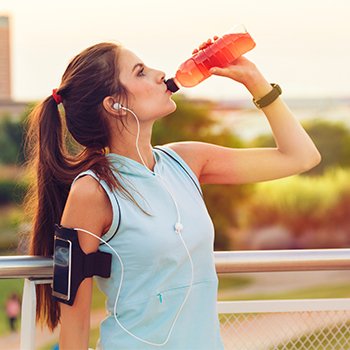เครื่องดื่มเสริมสมรรถภาพทางการออกกำลังกายและการวิจัยที่เกี่ยวข้อง Exercise Performance-Enhancing Drinks and Its Related Research
1447 Views |

By: ผศ. ดร. คุณัญญา มาสดใส
Assist. Prof. Kunanya Masodsai, Ph.D.
Exercise Physiology
Faculty of Sports Science
Chulalongkorn University
kunanya.m@chula.ac.th
1. รูปแบบเครื่องดื่มเพื่อสุขภาพที่ช่วยเสริมสมรรถภาพทางการออกกำลังกายและเล่นกีฬา
1.1 เครื่องดื่มเพื่อชดเชยน้ำ
ก) การสูญเสียน้ำในระหว่างออกกำลังกายเป็นกระบวนการสำคัญเพื่อถ่ายเทความร้อนออกจากร่างกาย (ร้อยละ 90 ผ่านทางเหงื่อ และร้อยละ 10 ผ่านทางการหายใจ)
ข) ผลต่างจากการชั่งน้ำหนักตัวทั้งก่อนและหลังออกกำลังกายจะเป็นดัชนีเพื่อบอกปริมาณน้ำที่สูญเสียไปจากการออกกำลังกาย
ค) เราไม่ควรสูญเสียน้ำมากกว่าร้อยละ 2 ของผลต่างจากการชั่งน้ำหนักตัว ระหว่างก่อนและหลังออกกำลังกาย
ดังนั้น เครื่องดื่มเพื่อชดเชยการสูญเสียน้ำจากร่างกาย จึงมีส่วนประกอบของน้ำในปริมาณมากและมีรสจืด โดยไม่จำเป็นต้องเติมสารให้พลังงาน
1.2 เครื่องดื่มเพื่อชดเชยเกลือแร่
ก) การสูญเสียเกลือแร่ในระหว่างออกกำลังกายจะเกิดในภาวะที่มีการออกกำลังกายอย่างหนักและนาน ซึ่งเหงื่อของเราจะเริ่ม “เค็ม” ซึ่งสังเกตจากเสื้อผ้าจะมีคราบเกลือเกิดขึ้น
ข) เกลือแร่หลักที่ถูกนำมาชดเชยและนำมาผสมในเครื่องดื่ม ได้แก่ โซเดียม โพแทสเซียม และคลอไรด์ (เกลือแร่อื่นเป็นเพียงการเสริมและอาจไม่มีความจำเป็น)
ค) การชดเชยเกลือแร่หลักข้างต้น มีส่วนช่วยในการลดการเกิดตะคริวที่กล้ามเนื้อ
ดังนั้น เครื่องดื่มเพื่อชดเชยการสูญเสียเกลือแร่จากร่างกาย จึงมีส่วนประกอบของเกลือแกงและเกลือแร่อื่น ๆ และมีรสเค็มเล็กน้อย
1.3 เครื่องดื่มเพื่อชดเชยสารพลังงาน
ก) สารพลังงานจะถูกเก็บสะสมไว้ที่กล้ามเนื้อ ตับ และเซลล์ไขมัน
ข) คาร์โบไฮเดรต แป้ง และน้ำตาล เป็นสารพลังงานที่ถูกนำมาใช้ได้อย่างรวดเร็ว สะดวก และถูกนำมาใช้เพื่อชดเชยพลังงานได้ง่ายที่สุด
ค) หากไม่มีการชดเชยสารพลังงานให้กับร่างกายจะนำไปสู่ภาวะอ่อนล้าอย่างรวดเร็ว
ดังนั้น เครื่องดื่มเพื่อชดเชยการสูญเสียสารพลังงานจึงมีส่วนประกอบของน้ำตาลและมีรสหวานเล็กน้อย
1. Types of healthy drinks with exercise and athletic performance-enhancing properties
1.1 Hydrating drinks
a) Water loss (90% through sweating and 10% through breathing) during exercise is a key thermoregulatory mechanism.
b) A change in body weight from pre-exercise to post-exercise typically indicates the amount of fluid lost during exercise.
c) Water loss should not exceed 2% based on the difference in body weight before and after exercise.
Therefore, typical hydrating drinks contain a large amount of water without flavor and energy substrate.
1.2 Electrolyte drinks
a) Mineral loss occurs during prolonged and intense exercise. It makes our sweat “salty”, as evidenced by the salt stains on our clothing.
b) The key minerals in electrolyte drinks are sodium, potassium, and chloride (additional minerals are optional and may not be necessary).
c) The key minerals listed above are essential for reducing muscle cramps.
Therefore, typical electrolyte drinks contain table salt and other minerals and are slightly salty.
1.3 Energy drinks
a) Energy-producing nutrients are stored in the muscles, liver, and fat cells.
b) Carbohydrates, starches, and sugars are energy-producing nutrients that the body can easily and rapidly convert to energy.
c) Lack of these energy-producing nutrients can lead to rapid tiredness and fatigue.
Therefore, typical energy drinks contain sugar and are slightly sweet.






